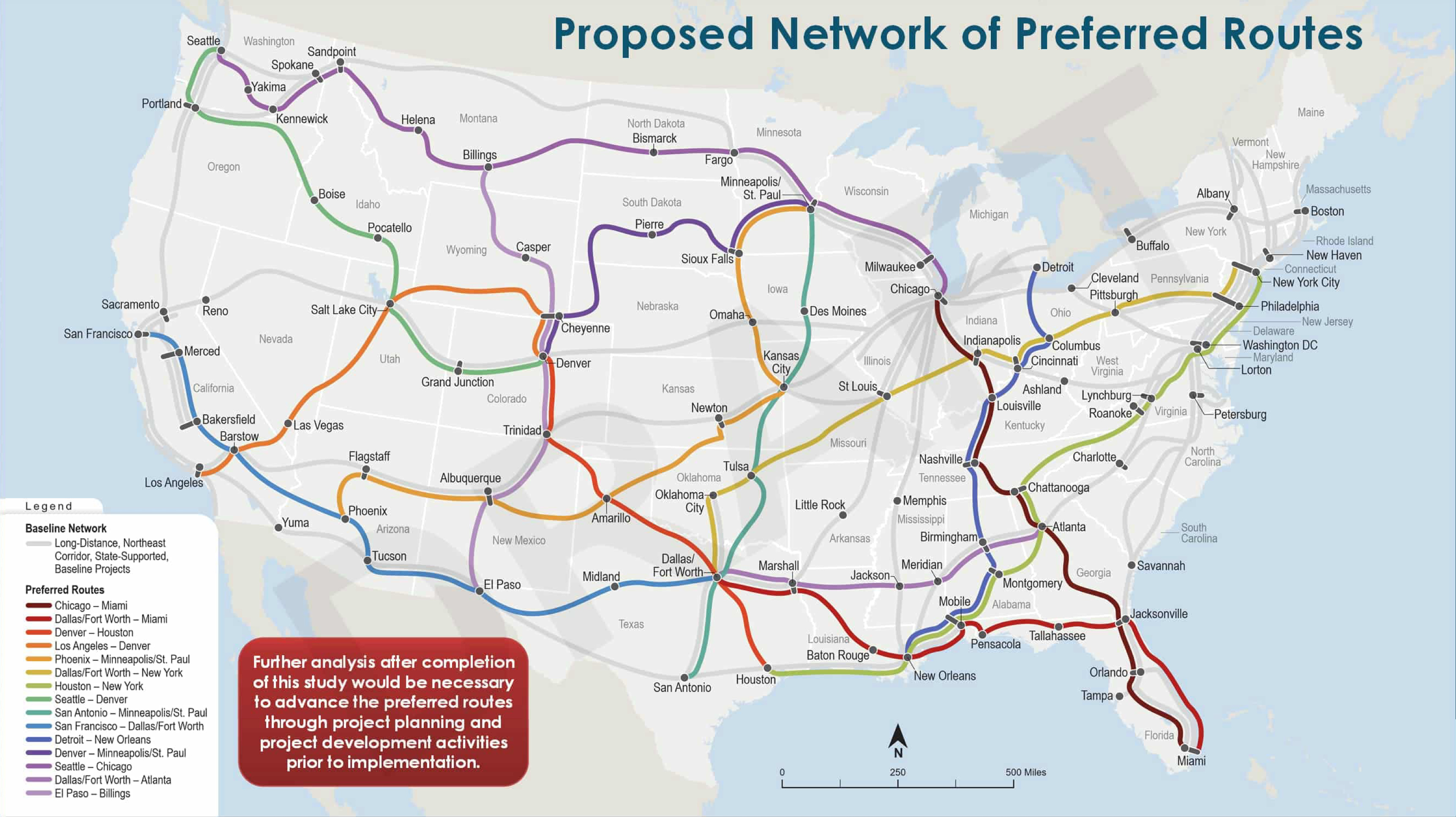The Federal Railroad Administration is workshopping suggestions of which long-canceled, money-losing Amtrak long-distance routes the passenger railroad might revive in the future.
(Before people get mad at FRA, this study was forced on them by section 22214 of the bipartisan infrastructure law (the IIJA), which orders the Secretary of Transportation to conduct a study to “evaluate the restoration of daily intercity rail passenger service along—(1) any Amtrak long-distance routes that, as of the date of enactment of this Act, were discontinued; and (2) any Amtrak long-distance routes that, as of the date of enactment of this Act, occur on a nondaily basis.”)
At this point, the draft study is progressing on the “if money were no object” track and is selecting recommended routes before figuring out how to pay for them. However, the statute does require FRA, in the final report, to “identify Federal and non-Federal funding sources required to restore or enhance the service described,” and the last few pages of the slide deck identify the methods that FRA will use to estimate the capital cost and operating costs for each route proposed to be restored or enhanced.
But what a map it is. (The faded gray lines are existing service.)

But what the law requiring this study is really about is reversing the course of the last 50 years, when President after President tried to get Amtrak to act like a corporation that was, if not profitable, at least not incredibly unprofitable each year, and that usually meant going after the long-distance trains. The decisions that would most be reversed, if the recommendations of the study are agreed to by Congress, would be those made in 1979. To recap:
Shortly after the August 1978 release of a GAO report entitled Amtrak’s Subsidy Needs Cannot Be Reduced Without Reducing Service, Congress enacted section 4 of the Amtrak Improvement Act of 1978, which ordered the Secretary of Transportation to come up with a plan to downsize the Amtrak route system. The law also declared that the changes would take effect unless either the House or Senate passed a resolution of disapproval (ah, the pre-Chadha days when life was simple).
On January 31, 1979, the report was issued, recommending a downsizing of total route length by 43 percent. The report noted “Because of its concentration of better routes, there will only be a 20 percent reduction in the number of passenger-miles and only a 9 percent decrease in ridership.” Extensive hearings were held. None of the disapproval resolutions were considered, with Congress instead enacting a new Amtrak authorization law on September 29, 1979 that took effect just two days before the route cuts were supposed to hit. Some of the more extreme route cuts proposed by the Carter DOT were rejected, but most were allowed to stand.
Among the routes that Congress allowed DOT to kill off in 1979 were the Floridian (Chicago to Miami), the Hilltopper (Boston to Catlettsburg, KY), the National Limited (Kansas City to D.C.), and the North Coast Hiawatha (Chicago to Seattle).
In his book Amtrak in the Heartland (Indiana U. Press, 2006), Craig Sanders summarizes some of these trains:
- Floridian – “Amtrak admitted in 1972 that the Floridian was its worst train, and four years later Passenger Train Journal observed that it had become ‘synonomous with all that is wrong with passenger railroading.’”
- Hilltopper – “Whenever a Washington bureaucrat or a congressman needed an example to show why Amtrak should trim its route system, the Hilltopper usually was it. Ridership was low, and the Hilltopper terminated in a small station in the middle of nowhere, departing before dawn and arriving just after midnight. Even some Amtrak supporters called the Hilltopper a joke.”
- National Limited – “Envisioned as an alternative east-west route bypassing Chicago, the National Limited should have been one of Amtrak’s better performers. It served 10 urban centers and the capitals of Missouri, Indiana, Ohio, Pennsylvania, and New Jersey. West of Pittsburgh, the National Limited crossed seven Amtrak routes in four cities. But bad track, chronic lateness, and a market that was nearly comatose when Amtrak began were too much to overcome.”
- North Coast Hiawatha – …”a formula that the Amtrak board was to sue to determine which trains survived. Long-distance trains had to average 150 passengers per trip and have an avoidable loss of no more than 7 cents per passenger mile. The North Coast Hiawatha did not meet that criterion, and it lacked enough political support to be saved by a regional balance exception that preserved some trains.”
According to Amtrak’s end-of-FY2023 unaudited financials, the passenger railroad’s long-distance trains (excluding the Autotrain, which is properly priced to break even), Amtrak’s average long-distance train costs $80.47 per mile to operate, but only brings in $35.14 per mile in revenue. That remaining $45.30 per train-mile (times 13.5 million train-miles) resulted in a $612 million operating subsidy that was paid by federal taxpayers. (The long-distance operating loss, again excluding the Autotrain, equals 19 cents per seat-mile, or 33 cents per passenger-mile.)
The FRA map proposes an additional 23,000 miles of preferred long-distance routes. At one train per day, and at $45.33 per train-mile on average, the operating subsidies for the new trains on the map would be around $1 million per day, in perpetuity, in addition to any capital costs for resumption of service.




